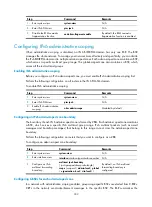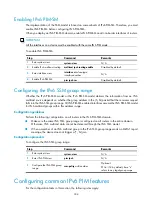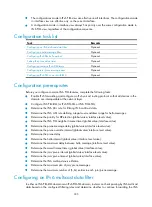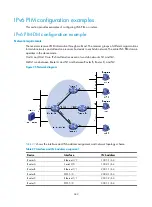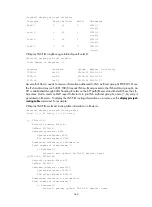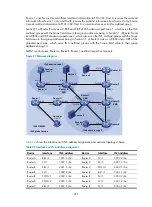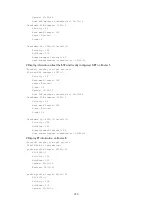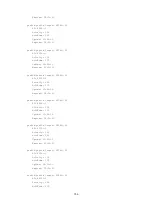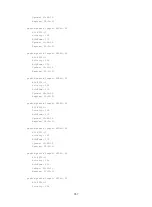
344
[RouterD] display pim ipv6 interface
Interface NbrCnt HelloInt DR-Pri DR-Address
Eth1/1 0 30 1 4001::1
(local)
Ser2/0 0 30 1 1002::2
(local)
Pos5/0 1 30 1 2002::2
(local)
Pos5/1 1 30 1 3001::2
(local)
# Display IPv6 PIM neighboring relationship on Router D.
[RouterD] display pim ipv6 neighbor
Total Number of Neighbors = 3
Neighbor Interface Uptime Expires Dr-Priority
1002::1 Ser2/0 00:04:00 00:01:29 1
2002::1 Pos5/0 00:04:16 00:01:29 3
3001::1 Pos5/1 00:03:54 00:01:17 5
Assume that Host A needs to receive information addressed to IPv6 multicast group G FF0E::101. Once
the IPv6 multicast source S 4001::100/64 sends IPv6 multicast packets to the IPv6 multicast group G, an
SPT is established through traffic flooding. Routers on the SPT path (Router A and Router D) have their (S,
G) entries. Host A sends an MLD report to Router A to join IPv6 multicast group G, and a (*, G) entry is
generated on Router A. To display the IPv6 PIM routing information on a router, use the
display pim ipv6
routing-table
command. For example:
# Display IPv6 PIM multicast routing table information on Router A.
[RouterA] display pim ipv6 routing-table
Total 1 (*, G) entry; 1 (S, G) entry
(*, FF0E::101)
Protocol: pim-dm, Flag: WC
UpTime: 00:01:24
Upstream interface: NULL
Upstream neighbor: NULL
RPF prime neighbor: NULL
Downstream interface(s) information:
Total number of downstreams: 1
1: Ethernet1/1
Protocol: mld, UpTime: 00:01:20, Expires: never
(4001::100, FF0E::101)
Protocol: pim-dm, Flag: ACT
UpTime: 00:01:20
Upstream interface: Serial2/0
Upstream neighbor: 1002::2
RPF prime neighbor: 1002::2
Downstream interface(s) information:
Total number of downstreams: 1
1: Ethernet1/1
Protocol: pim-dm, UpTime: 00:01:20, Expires: never



